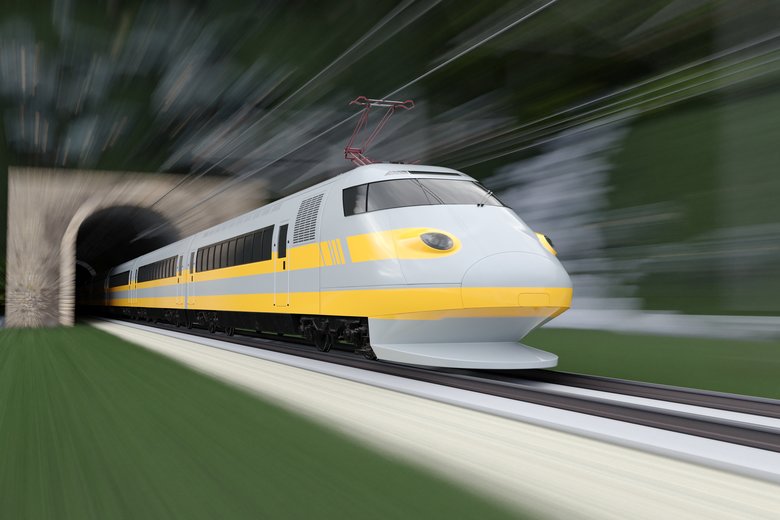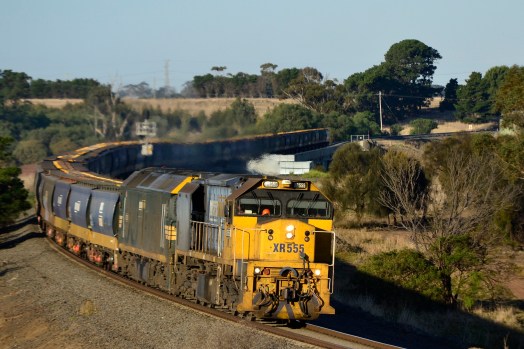
A bullet train won’t work in Australia, nor will it be the climate saver many policy makers believe it will be, according to the authors of a report by a public policy think tank.
The report was released by the Grattan Institute the month. It argues that bullet trains are unsuitable for Australia, past feasibility studies are flawed and that governments should stop using public money to continually study proposals.
It also says other options for high-speed rail should only be considered if the benefits can be demonstrated by a transparent cost-benefit analysis.
A costly megaproject

Building a 350 kph bullet train, similar to the Eurostar, Japan’s Shinkansen or France’s TGV, along the country’s east coast, a plan put forward by Labor when it was last in government, would require massive new track infrastructure and take 50 years to build.
The estimated $130 billion price tag would make it a “mega-megaproject” with dubious benefits, one of the report’s authors Greg Moran says.
The other option of rail renovation to improve existing rail lines, such as electrifying them, could achieve train speeds of more than 200 kph but is yet to be the subject of a proper business case, he says.
Fellow author, Tom Crowley, says Australia’s population and geographical conditions aren’t suitable for a bullet train.
Unlike countries like China and Japan where high speed rail has had success, Australia has a smaller and more spread out population.
“It would require about 2000 km of track that we would be building here for about 15 million people,” he says in a podcast prepared by the institute.
Emissions fallacy
The report also challenges the notion that a bullet train will reduce emissions, as it will cut demand for air travel.
Moran says a project of the nature and scale of a bullet train might actually create more emissions than it saves, at least for the first 40 years.
“The problem lies in the construction and the vast amounts of concrete and steel it would need,” he says.
“Constructing this bullet train line would be incredibly emissions intensive in itself and building this bullet train may actually lead to emissions being higher than they would otherwise for a very long time.
“Any sense that bullet train is going to make a massive dent in our emissions isn’t really true.”
Cost benefits

The report also questions the cost-benefit analysis of a bullet train contained in Labor’s 2013 feasibility study, saying it was based on unrealistic assumptions.
Mr Moran says the original cost benefit for the project was estimated at 2.3 to 1, or $2.30 of benefits for every $1 invested.
However he says taking into account adjusted discount rates, emissions costs and the building of a second Sydney airport, Grattan’s cost benefit analysis is closer to 1 to 1.
“That means you’d build this thing and get no net benefits or net costs,” he says.
Governments needed to consider whether the $130 billion could be better spent elsewhere, such as upgrading rail networks in poorly connected outer urban areas or boosting freight infrastructure and internet connectivity in regional areas, he says.
The notion that a bullet train will benefit regional areas and boost tourism is also taken up in the report.
Mr Crowley says overseas experiences have shown this isn’t necessarily the case.
In France, Paris benefited from a high speed rail more than the regions, while in Spain it resulted in more day trips but few night stays, he says.
Report ‘totally wrong’
High speed train advocate Anthony Albanese said the report had got it “totally wrong”.
“They didn’t bother to actually read the study that was done when we were in Government. It was completed in two stages that showed that it would produce a positive economic return of over two dollars, between Sydney and Melbourne via Canberra has a very positive economic return,” the Labor leader told radio 2CC after the Grattan report was released.
“And it would create significant regional economic development, including, of course, in Australia’s largest inland city, our national capital.”
Time to stop obsessing about big things
But Mr Crowley says Australia needs to drop its obsession with big things and not let the need for post-COVID stimulus cloud decision making.
“Focusing on the objective is really important, rather than focusing on doing something big just because we like building big things,” he says.
The only way to decide whether to invest in any project by preparing a business case and conducting an independent cost benefit analysis.
“We might be eager for stimulus in a post covid world and there may be some good reasons for that but it doesn’t mean you get to through the rule book out the window,” he said.
“You’ve got to make sure that anything you’re spending public money on will clearly benefit the public more than it will cost.
“We think that a bullet train clearly won’t do that.”
Comment below to have your say on this story.
If you have a news story or tip-off, get in touch at editorial@governmentnews.com.au.
Sign up to the Government News newsletter

Ah, sense at last. Congratulations Tom Crowley.
I’m an advocate of high-speed rail in Australia, but I’m not bull-nosed about it. I’m more than happy to take on board deep research and plenty of points of view when debating it. This is exactly what we should be doing in a democracy! Yes, deep analysis may find that HSR is not a suitable option for the Australian east coast. I also very much respect the work of the Grattan Institute.
However, the rationale posited above feels academic rather than practical and there is barely any chatter about the already existing benefits to countries that have adopted HSR, particularly in Europe. The focus of the conversation above (at least in this article) focuses on the negative aspects and ignores some of the positive aspects.
For example, in London – HSR allows the capital to continue to work as a centre of commerce while providing a mechanic for those working in London to commute weekly into and out of destinations like Manchester, Liverpool etc. In Australia, the equivalent of this would be Newcastle for example.
HSR has meant that while the amount of commerce in the city grows, the infrastructure in the cities has not had to feel increasing infrastructural pain points as workers move in and out of the city either daily or on weekends. This would mean that someone living in Newcastle could easily work in the Sydney CBD, at least far more easily than they do now. T
It also means the economic fruits earned in the city (the salaries!) are far more likely to redistributed out in to the smaller regional areas when workers have a more efficient option of commuting. This means more spend on things like property, consumer goods, education and general daily needs (like cleaners, pubs, restaurants, cafes etc.)
This is just one area! I could write an essay here on the benefits. It is really about exploring the nuanced benefits that big studies miss.
Figures in the article like “50 years to build” are frustrating. The HSR Channel Tunnel between London and Paris (and across then floor of the English Channel!) took 6 years to build. Surely, that was a far more complicated build than this one? It also included border crossings and additional security and passport controls….
Finally – HSR doesn’t need to be a “Bullet Train”. Europe doesn’t use Bullet Trains. The words “Bullet Train” have the potential to sensationalise this issue because they are words that are potentially polemic and visually leap off the page. Let’s approach and talk about the issue using the correct terminology and encourage a mature debate.
I agree that HSR is not suitable or viable in our country. However magnetic lev trains of High speed may well be.
Anything on ground rail has high costs on the environment with noise and large corridors and lots of issues with keeping wildlife out of those corridors.
A ground based rail line has a 7k wide noise corridor.
Our existing tracks and roads are not where new HS trains would run – especially on the east coast.
Putting a HS train up on pylons in a more direct route with less impact on ground wildlife (kangaroos etc) makes sense to me – if its economically viable.
Hallelujah, Transrapid Maglev bid to major projects Vic as recently as 2008, for $32M per km so only $32B if 1000km to Sydney,
-cruising speed +430kmh,
-joint venture Shanghai 4 years build/install
-never missed a beat since 2006 no contact, no wear and tear
-factory production line modules
-no new real estate or huge earth moving to smooth out hills and curves, can handle same terrain alongside freeway
-consumes only 30% of power of HSR(high speed rail)
-just a pity knocked back by Sir Rod Eddington expert up in air but less so on ground
More likely that Angus will sort us out with coal fired steam train, BERNIE.
We need more regional train services, not faster ones.
We need all the passenger rail services which were closed down forty years ago urgently reinstated. We need the Bourke line upgraded and passenger services reinstated. We need the Cowra line upgraded and passenger services reinstated. We need the Tottenham line upgraded and passenger services reinstated. We need the Nyngan line upgraded and passenger services reinstated and the list goes on and on.
Locals in these areas have been signing petitions for ages now to get all these rail services back on track, but no one is listening.
Rather than provide this much-needed infrastructure, the government insists on ripping up country rail lines left, right and centre and then turns them into cycle ways. How idiotic is that??
It’s time the government started listening to what the people in country areas actually need and want instead of coming up with these stupid “pipe dreams” of fast trains and rail trails.
Most commuters would be quite happy with a lot more average-speed trains that criss-crossed the entire state and actually got them to where they really needed to go, rather than a couple of flashy fast trains that are only there to impress tourists up and down the east coast.
The government says it wants to stimulate jobs growth and decentralisation, but does very little in that direction. Upgrading and reinstating all these dormant and/or under-utilised lines in regional NSW will stimulate long term jobs growth across the board. And the rewards the communities will reap from their reinstatement will last for decades, if not centuries to come.
So, ditch the fast train crap and give us what we really want, which is MORE rural and regional train services.
Even the lest used Shinkansen (completed) lines in Japan turn a profit and the Kyushu Shinkansen used to get far less usage than the Melbourne – Sydney air corridor. So as long as we don’t get carried away as Spain did, I see no reason why we can’t emulate the Kyushu Shinkansen here in Australia.
Travel between for commuters and tourist will be revolutionised by electric aircraft.
Cheap travel by air will make train travel uneconomic. Towns without air travel will have
services provided and be cost effective. Short haul routes not economic now will become
so as the technology is here and will change the way we move short distances ie 1000km
and less.
Journey times alone
Qantas or Virgin say It takes 1 hour from Sydney to Canberra, [plus check in time] Say 2 hours [(286 kph) elapse time speed 146 kph] , Car journey is at least 3 hours [95 kph] for the 286 kilometre journey. currently by train 4 hours and 8 minutes [71 kph],
HS1 Current High speed rail (UK) 225 kph. [this isn’t a bullet train}
Look at the TGV or Shinkansen speed 300 Kph.
Is there any economic justification for not having at least 225 kph Train service. HS1
Hi Kim,
Leighton’s study circa 1989 voted for the TGV over the Mag-lev and one other. At the time, the TGV did 320 k/hr. The ‘new’ one goes 590 k/hr and has a post on You Tube. In 2013 this was published:
https://switzersuperreport.com.au/leighton-ugl-and-downer-edi-all-have-their-eyes-on-a-fast-train/
I solidly disagree with Greg Moran and Tom Crowley. It’s not ALL about return on investment. It’s about a sensible cost transport medium that competes with air travel. It’s about beating the cost and pollution levels of air travel for Australians. It’s a GREAT employment project for metropolitan and regional Australia in the construction AND maintenance of the Very Fast Train, (VFT). By the way, the ‘new’ TGV goes 590 k/hr. That’s a quick trip from Melbourne to Canberra or Sydney. Let’s not do another study. Lets turn the first sod!
Fix up the dreadful state of Sydney to Melbourne – just get a proper inter city train going all the way at more than 100 km per hour would be progress. Of course it needs to be faster with a straighter line, but at present it is just hopeless; the line is seriously inadequate and needs substantial investment in maintenance and upgrading – now!
It would be good to make it easy to roll on and roll off your bicycle too!
Bike trails on closed railways are a side issue. Railways should go back on railway lines. Bikeways are essential but should be built elsewhere;
and of course country trains should be re-instated where they have been closed and lines doubled up where they are reduced to single track. It isn’t even easy to get to Canberra by train. Or to major centres like Bathurst, Dubbo or Lismore. Many of us don’t want to fly or drive or take a laboriously slow bus. We want to travel by efficient, regularly scheduled, passenger trains.
No I believe we should’ve gotten it all Nationalised as Australia Rail running from state to ACT from a large Canberra Terminal unfortunately not happening
HSR should be Adelaide to Perth
From E.F